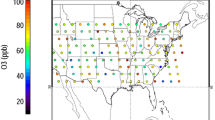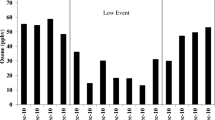Abstract
The Lake Tahoe Basin is located on the California-Nevada border and occasionally experiences elevated levels of ozone (O3) exceeding the California Air Resources Board ambient air quality standard (8-h average). Previous studies indicate that both the local generation and long-range transport from out-of-basin sources are important in contributing to O3 exceedances, but little is known about the impact of regional meteorology on O3 source regions. To develop a better understanding of the factors affecting O3 levels and sources in the Lake Tahoe Basin, a comprehensive field study was performed in the summer of 2010. Included in this effort was a meteorological analysis addressing potential regional meteorological influences leading to periods of elevated levels of O3. Three approaches were used to conduct the analysis: (1) regional atmospheric pressure difference (i.e., the Washoe Zephyr) to access potential transport, (2) back trajectory modeling using the Hybrid Single-Particle Lagrangian Integrated Trajectory (HYSPLIT) model to determine where the air masses originated and, (3) composite soundings to evaluate in-Basin atmospheric influences. These analyses indicate the Washoe Zephyr did not strongly impact O3 levels; however, higher O3 levels were found to correspond with both a more southerly wind component and a dip in dew point temperature around 400 hPa. The results also indicate that if transport does occur, it is more likely to come from the San Joaquin Valley and move to the southern part of the Basin, rather than originating in the large cities to the west (i.e., Sacramento and San Francisco).














Similar content being viewed by others
References
Air Resources Laboratory (2014) Ready archived meteorology. http://www.arl.noaa.gov/. Accessed 9 April 2014
American Lung Association (2014) State of the air report. http://www.stateoftheair.org. Accessed 14 March 2014
Atkinson BW (1981) Meso-scale atmospheric circulations. Academic Press, New York
Banta RM, Senff CJ, Alvarez RJ, Langford AO, Parrish DD, Trainer MK, Darby LS, Hardesty RM, Lambeth B, Neuman JA, Angevine WM (2011) Dependence of daily peak O3 concentrations near Houston, Texas on environmental factors: wind speed, temperature, and boundary-layer depth. Atmos Environ 45:162–173
Berman S, Ku JY, Rao ST (1999) Spatial and temporal variation in the mixing depth over the Northeastern United States during the summer of 1995. J Appl Meteorol 38:1661–1673
Bognar JA, Birks JW (1996) Miniaturized ultraviolet ozonesonde for atmospheric measurements. Anal Chem 68:3059–3062
Burley JD, Theiss S, Bytnerowicz A, Gertler A, Schilling S, Zielinska B (2015) Surface ozone in the Lake Tahoe Basin. Atmos Environ 109:351–369
Bytnerowicz A, Arbaugh M, Padgett P (2004) Evaluation of ozone and HNO3 vapor distribution and ozone effects on conifer forests in the Lake Tahoe Basin and eastern Sierra Nevada. Final Report to California Air Resources Board, Contract No. 01-334, USDA Forest Service, Pacific Southwest Research Station. http://arbis.arb.ca.gov/research/apr/past/01-334.pdf. Accessed 26 March 2014
Bytnerowicz A, Fenn M, Gertler A, Preisler H, Zielinska B (2013) Distribution of ozone, ozone precursors and gaseous components of atmospheric nitrogen deposition in the Lake Tahoe Basin. Final Report to California Air Resources Board, Contract No. P063, USDA Forest Service, Pacific Southwest Research Station
Carroll JJ, Dixon AJ (2002) Regional scale transport over complex terrain, a case study: tracking the Sacramento plume in the Sierra Nevada of California. Atmos Environ 36:3745–3758
Carroll JJ, Miller PR, Pronos J (2003) Historical perspectives on ambient ozone and its effects on the Sierra Nevada. Dev Environ Sci 2:33–54
Cox P, Delao A, Komorniczak A, Weller R (2009) The California almanac of emissions and air quality, California Air Resources Board, Sacramento. http://www.arb.ca.gov/aqd/almanac/almanac09/almanac09.htm. Accessed 24 Feb 2014
Dabdub D, DeHaan LL, Seinfeld JH (1999) Analysis of ozone in the San Joaquin Valley of California. Atmos Environ 33:2501–2514
Dolislager LJ, VanCuren R, Pederson JR, Lashgari A, McCauley E (2012) An assessment of ozone concentrations within and near the Lake Tahoe Air Basin. Atmos Environ 46:645–654
Draxler RR, Rolph GD (2010) HYSPLIT (Hybrid Single-Particle Lagrangian Integrated Trajectory) Model Access via NOAA ARL READY Website. NOAA Air Resources Laboratory, Silver Spring. http://www.ready.arl.noaa.gov/HYSPLIT.php. Accessed 25 Feb 2015
Furger MJ, Dommen WK, Graber L, Poggio ASH Prévôt, Emeis S, Grell G, Trickl T, Gomiscek B, Neininger B, Wotawa G (2000) The VOTALP Mesolcina Valley Campaign 1996 Concept, background and some highlights. Atmos Environ 34:1395–1412
Gertler AW, Bytnerowicz A, Cahill TA, Arbaugh M, Cliff S, Koračin JK, Tarnay L, Alonso R, Frączek W (2006) Local pollutants threaten Lake Tahoe’s clarity. Calif Agric 60:53–58
Haman CL, Couzo E, Flynn JH, Vizuete W, Heffron B, Lefer BL (2014) Relationship between boundary layer heights and growth rates with ground-level ozone in Houston, Texas. J Geophys Res Atmos 119:6230–6245. doi:10.1002/2013JD020473
Held T, Ying Q, Kaduwela A, Kleeman M (2004) Modeling particulate matter in the San Joaquin Valley with a source-oriented externally mixed three-dimensional photochemical grid model. Atmos Environ 38(22):3689–3711
Lagarias JS, Sylte WW (1991) Designing and managing the San Joaquin Valley air quality study. J Air Waste Manag Assoc 41:1176–1179
Mesinger F et al (2006) North American regional reanalysis. Bull Am Meteorol Soc 87:343–360. doi:10.1175/BAMS-87-3-343
NAS report (2010) Global sources of local pollution—an assessment of long-range transport of key air pollutants to and from the United States. The National Academies Press. http://books.nap.edu/openbook.php?recordid=12743\&page=35. Accessed 24 June 2014
Ranzieri AJ, Thuillier RH (1994) SJVAQS and AUSPEX: a collaborative air quality field measurement and modeling program. Planning and Managing Regional Air Quality, Solomon
Rappenglueck B, Perna R, Zhong S, Morris GA (2008) An analysis of the vertical structure of the atmosphere and the upper-level meteorology and their impact on surface ozone levels in Houston, Tex. J Geophys Res 113:D17315. doi:10.1029/2007JD009745
Twain M (1871) Roughing it. New York
Whiteman CD (1990) Observations of thermally developed wind systems in mountainous terrain. Atmospheric processes over complex Terrain. Meteorological Monographs, No. 45. American Meteorological Society, pp. 5–42
Whiteman CD (2000) Mountain meteorology: fundamentals and applications. Oxford University Press, Oxford
Zhang Q, Carroll JJ, Dixon AJ, Anastasio C (2002) Aircraft measurements of nitrogen and phosphorus in and around the Lake Tahoe Basin: implications for possible sources of atmospheric pollutants to Lake Tahoe. Environ Sci Technol 36:4981–4989
Zhong S, Li J, Clements CB, De Wekker SFJ, Bian X (2008) Forcing mechanisms for Washoe Zephyr—a daytime downslope wind system in the lee of the Sierra Nevada. J Appl Meteorol Clim 47:339–350
Acknowledgments
This study was supported by a grant from the US Department of Agriculture Forest Service through the Tahoe Science Program funded by the Southern Nevada Public Lands Management Act (SNPLMA). The authors also would like to thank Joey Keely, Chris Engelhardt, Paul McCulloch, and Shana Gross of the US Department of Agriculture (USDA) Forest Service Lake Tahoe Basin Management Unit; Andrew Strain and Casey Blann of the Heavenly Mountain Skiing Operations, Dennis Malone of the Thunderbird Lodge, and Jack Coughlin of Diamond Peak Skiing Operations; Brant C. Allen of UC Davis Environmental Research Center and Chris Ross of the USDA Forest Service PSW Research Station; Jonathan Long and Tiffany Van Huysen of the USDA Forest Service PSW Research Station for administrative support for the study. A special thanks to the collaborators: Suraj Ahuja, Ricardo Cisneros, Glen Shaw, Don Schweizer, and Trent Procter of US Forest Service Region 5; Susan Schilling of the US Forest Service Pacific Southwest Research Station; Mark McDaniel of the Desert Research Institute; Miriam Rorig of USDA Forest Service PNW Research Station. Thanks also to Nyssa Perryman for help and support.
Author information
Authors and Affiliations
Corresponding author
Additional information
Responsible Editor: S. T. Castelli.
Rights and permissions
About this article
Cite this article
Rayne, S., Gertler, A., Zielinska, B. et al. Impact of regional meteorology on ozone levels in the Lake Tahoe Basin. Meteorol Atmos Phys 129, 297–308 (2017). https://doi.org/10.1007/s00703-016-0471-z
Received:
Accepted:
Published:
Issue Date:
DOI: https://doi.org/10.1007/s00703-016-0471-z




